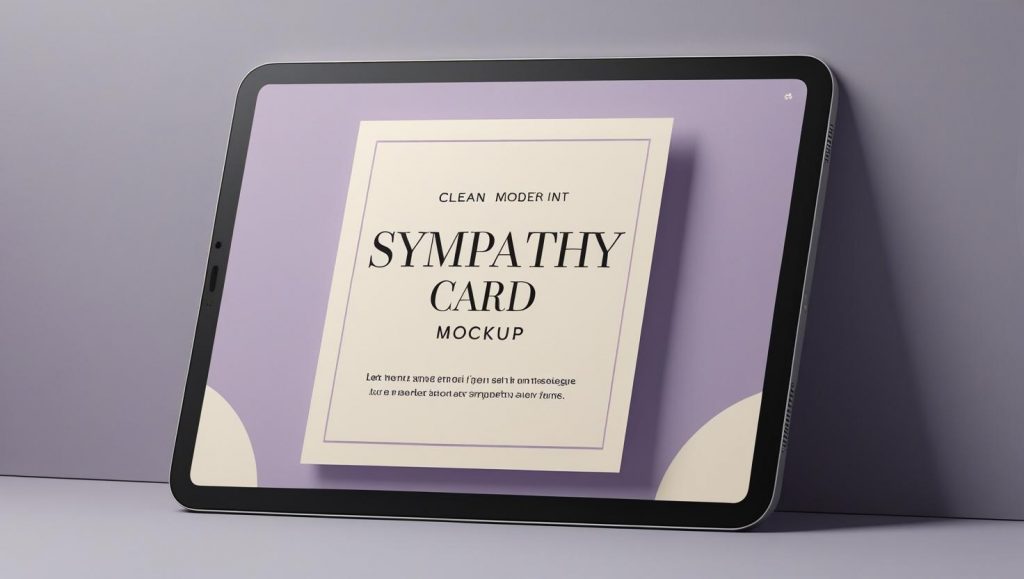In front of grief, words can feel both necessary and inadequate. When someone loses a loved one, a message sent with kindness and care—even through a simple digital sympathy card—can offer meaningful comfort. But many of us struggle to know what to say. How do you create sympathy ecard messages that truly resonate, provide condolence support and reflect your real compassion?
This guide is written with insights from grief consultants and communication experts, here to help you find the right words. Whether you’re sending a message to a colleague, friend, family member, or someone in the UK.
Why Digital Sympathy Cards Matter
In today’s fast-paced, global world digital sympathy cards have become a thoughtful and timely way of reaching a few-when the distance makes the physical card impractical. A digital sympathy card not only takes your words; It can offer a sense of presence and care at a deeply emotional moment.
But the responsibility comes with convenience. The ease of sending a quick message shouldn’t come at the cost of emotional depth. This is not just about sending a message – it’s about saying the correct message.
Start With A Gentle Tone: Tips to Set the Mood
Before writing a simple word, Take a breath and consider the emotional landscape you’re writing into. Grief is heavy and personal. Your message should feel soft, slow and honest. Here are some soft tips to guide you:
- Avoid overly casual phrases (e.g., “That sucks,” or “Everything happens for a reason.”)
- Skip jokes or attempts to lighten the mood unless you know it’s welcome.
- Use simple, heartfelt language.
- Let empathy guide your tone over etiquette or formality.
Start your message by accepting the loss. This shows the recipient that you see their pain and that your message is actually for them-not a copied message” or “impersonal message.

Examples of Thoughtful Sympathy Ecard Messages
Here are several types of sympathy ecard messages you can adapt for different people and situations:
For a Close Friend
“I’m so sorry for your loss. I know how much [Name] meant to you, and I can’t imagine the sadness you’re feeling. I’m here—whenever you need to talk, sit in silence, or just be.”
For a Coworker or Acquaintance
“Sending heartfelt condolences to you and your family. I hope you find comfort in the love and memories you shared.”
For Someone Who Lost a Parent
“There are no words to ease a loss like this, but please know I’m thinking of you. Your [Mom/Dad] was a remarkable person, and they will never be forgotten.”
For a Pet Loss
“I’m so sorry for the loss of your beloved [Pet’s Name]. Our animal companions leave pawprints on our hearts forever.”
These messages work because they are short but warm, focused on the person who grieves – not on you – and free of cliché. They are perfect to include in a digital sympathy card that can be customized with soft colors, soft views and your thoughtful note.
Incorporating Condolence Messages and Loss Quotes
Sometimes it is difficult to find the original words, and that’s fine. Well-chosen condolence messages and meaningful losses quotes can be comforted without leaving uninterrupted.
Here are a few examples to consider:
“Grief is the price we pay for love.” – Queen Elizabeth II
“What we once enjoyed and deeply loved we can never lose, for all that we love deeply becomes part of us.” – Helen Keller
“May the sorrow you feel in your heart lighten by the love that surrounds you.”
These can be included as the main message or as a follow-up line to your personal note. Be careful not to overwhelm the recipient with too much text—one or two lines can be enough.
Timing Matters: When Should You Send a Sympathy Message?
A question that often arises: How soon should you send the condolences? Once you learn of the loss, it’s best to send a message as soon as possible. Although it is never late to express care, your support in the early days shows compassion and care.
Even if you’re unsure of the perfect words, don’t delay—your support matters more than saying everything perfectly. A simple message like ‘I’m thinking of you’ can make a world of difference when the pain is still fresh.
And remember: Just because you have sent a message does not mean that you cannot follow. Many people move on a few weeks after the loss, but for the grieving person, the pain often lingers. Later checks with a small note, “Still thinking about you. How do you catch these days?” Can be incredibly meaningful and comforting.
When Faith Comes Into Play: Using Religious References Respectfully
In the time of grief, spirituality and faith can be a deep source of comfort or a delicate subject. One of the most asked questions about sympathy ECARD messages is whether it is appropriate to include religious references. The answer depends entirely on the assumptions of the recipient – not their own.
If you know that a grieving person is religious, it can be a beautiful gesture to incorporate trust -based condolence message. For example:
“May God grant you peace and comfort in this time of sorrow.”
“Lifting you in prayer during this time of loss.”
“May their soul rest in eternal peace.”
These messages are commonly well-received in both the U.S. and the UK, particularly in Christian families, such expressions are often welcomed.
However, if you are unsure of someone’s faith – or if they are secular – it is the safest to use more universal losses or comfortable phrases. You don’t want your message to feel out of touch or disconnected. A simple, cordial line, such as “You Wish for Strength and Peace in the Days Ahead” works in trust systems.
The key is to make your message feel personal, not presumptive.

Specific Situations: Messages Tailored to the Type of Loss
Each loss is unique, and your words should reflect the unique pain someone is experiencing. How to tailor your sympathy -ECard messages for different types of grief while keeping tone kind and appropriate.
For the Loss of a Spouse
“I’m deeply sorry for the loss of your partner. The love you shared was visible to everyone around you. May you find peace in the memories you built together.”
A message like this reflects the depth of the relationship while honoring their ongoing grief.
For the Loss of a Sibling
“No words can ease the sorrow of losing a sibling. I hope you can feel surrounded by love during this time, and I’m here for anything you need.”
Acknowledge the lifelong bond siblings share and offer your continued presence.
For the Loss of a Child
“My heart aches for you and your family. I cannot imagine the weight of this loss, but please know I am holding space for you in my thoughts every day.”
With losses this profound, words will never be enough. Keep it gentle and simple, and allow your message to reflect your empathy rather than attempts at comfort that might fall flat.
For Miscarriage or Infant Loss
This is often an overlooked grief, and it’s important not to minimize the pain.
“I’m so sorry for your heartbreaking loss. Though their time was brief, their impact was everlasting. Please know you’re not alone.”
Offering quiet support—especially through a digital sympathy card that doesn’t require verbal conversation—can be incredibly meaningful.
What to Say in a Group Sympathy Ecard
Group-e cards are often used in workplaces, clubs or shared communities, and it can be difficult to prepare a message in that context. You will be respectable without being extremely intimate, especially if you do not know well.
Here are a few ways to contribute to a group card with dignity:
“On behalf of the team, please accept our sincere condolences. We’re keeping you in our thoughts and sending support during this difficult time.”
“We’re so sorry to hear of your loss. Wishing you comfort and peace from all of us at [company/team name].”
If many people contribute, it’s okay if your patch is small. Avoid repeating others’ exact words, and don’t feel pressured to make your message anymore -when they are thoughtful and at the time, the sympathy ecard messages are the most powerful.
Bereavement Support Beyond Words
Sometimes, people worry that a message isn’t enough. They wonder if they should do more—or if reaching out again later is necessary. The answer? Absolutely yes.
Even a week or two after sending your digital sympathy card, consider following up with a short message that says:
“I’ve been thinking about you—no need to respond. Just wanted to let you know you’re not forgotten.”
Grief doesn’t end after the funeral. Often, the quiet period afterward is the hardest. That’s when bereavement support becomes especially meaningful. Don’t underestimate how impactful it is to check in gently weeks later.
You could also offer specific help if you’re close to the person:
“If you ever want a quiet coffee or help with errands, I’m here. No pressure—just wanted to offer.”
Don’t say, “Let me know if you need anything,”—people rarely ask. Offer one simple act of kindness instead.
Supporting Colleagues and Professional Contacts
In the workplace, grief can be even more different. If a colleague is grieving, a digital card is a thoughtful and respectful gesture that allows them to get support without putting them on the spot.
Keep it simple:
“Thinking of you during this time. Wishing you peace and strength as you take the time you need.”
“We’re all sending you our heartfelt condolences. Please know you’re missed and supported.”
This kind of sympathy ecard message lets the person know their pain is acknowledged, without placing emotional demands on them while they’re still navigating their loss.
Language to Avoid in Sympathy Ecard Messages
Finding the right words also means knowing what not to say. Even with the best intentions, certain phrases can unintentionally cause discomfort or make the grieving person feel misunderstood. Here are some phrases to avoid in digital sympathy cards:
- “They’re in a better place.”
→ While this may align with your beliefs, it may not match theirs. Stick to what you know: their grief, their loss, and your care. - “At least they lived a long life.”
→ Even long lives are grieved deeply. This can sound dismissive. - “Everything happens for a reason.”
→ Grief doesn’t always need explanations—it needs acknowledgment. - “I know how you feel.”
→ No one feels grief in the same way. Instead, say “I’m here for you” or “I’m thinking of you.” - “Be strong.”
→ People often feel pressure to “perform” their grief in socially acceptable ways. Let them know it’s okay to feel however they’re feeling.
Focus your message on comfort, presence, and listening—rather than resolution.

Best Practices for Formatting a Digital Sympathy Card
When designing or choosing a digital sympathy card, the visuals should echo the message: calm, respectful, and sincere. Here are a few key pointers to get it just right:
1. Use Soothing Color Palettes
Muted blues, soft greys, lavender, and warm beige tones work beautifully. Avoid overly bright or jarring colors.
2. Choose Clear and Calm Fonts
Use elegant serif or rounded sans-serif fonts for a soft appearance. Avoid cartoonish or overly stylized typefaces.
3. Keep the Message Legible
If your digital card has a background image (e.g., flowers, sky, candles), ensure there is enough contrast between the text and background so that the message is easy to read.
4. Avoid Clutter
Don’t overload the card with multiple quotes or long paragraphs. Choose one central message or two short lines—especially when writing on behalf of a group.
5. Consider Including a Quote
Here are a few gentle loss quotes that work beautifully in digital sympathy cards:
“Those we love don’t go away. They walk beside us every day.”
“There is no footprint too small to leave an imprint on this world.”
“What is lovely never dies, but passes into other loveliness.” – Thomas Bailey Aldrich
The simplicity and softness of your message is what makes it resonate.
Follow-Up Matters: Checking In Again Later
One of the most overlooked parts of sending a sympathy message is the follow-up. Many people wonder, “Should I check in again later?” The answer is yes—especially after the initial outpouring of support dies down.
Two to three weeks after sending your digital sympathy card, consider sending another short note or message like:
“You’ve been on my mind lately. No need to reply—I just wanted you to know I’m still here for you.”
For close friends or family, follow-ups can include offers of practical support: sharing a meal, going for a walk, helping with errands. For coworkers, even a small message such as “We’re still thinking of you and sending support” can remind them they’re not forgotten in their grief.
Remember: grief doesn’t have a set timeline. Your consistent kindness is part of the ongoing bereavement support that truly matters.
Short and Gentle Sympathy Message Templates
To make this article truly helpful, here’s a curated set of sympathy ecard message templates that you can use, personalize, or adapt:
Simple and Universal
“Thinking of you and sending comfort during this time of loss.”
“My heart goes out to you. Wishing you peace and healing.”
“You are in my thoughts, and I’m so sorry for your loss.”
Heartfelt but Brief
“With love and sympathy.”
“Holding you close in my thoughts.”
“May your heart find peace in the days ahead.”
Spiritual or Faith-Inspired
“Praying for you and your family during this difficult time.”
“May you find comfort in God’s everlasting love.”
“Blessings and peace to you.”
For Close Friends or Deep Losses
“There are no words, but please know I’m here for you always.”
“I will always remember [Name] and the light they brought into your life. My heart is with you.”
“When you’re ready, I’m here—to talk, to sit, or just to be.”
These examples are American and British the gentle tone of the audience of both reflecting a balance between tips, real emotions and fitness. You don’t need poetic language or complex ideas – just care carefully.
Wrapping It All Together: Final Thoughts
Writing a sympathetic ecard message is never easy – but it makes it so meaningful. This isn’t about crafting the perfect sentence. It’s about showing for someone in deep pain, and saying: You’re not alone.
A well -written message, given through a thoughtful digital sympathy card, can serve as a small but powerful anchor for someone whose the world has just shaken.
Looking for more ways to celebrate and support life’s milestones? Explore our collection of free retirement and get-well eCards to share your care anytime.


